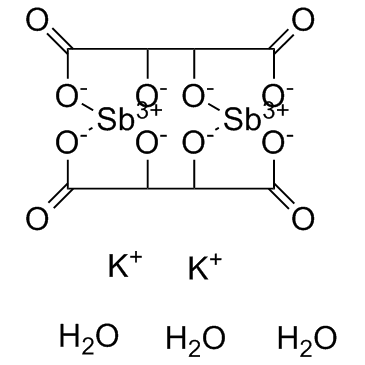Potassium antimonyl tartrate sesquihydrate

Potassium antimonyl tartrate sesquihydrate structure
|
Common Name | Potassium antimonyl tartrate sesquihydrate | ||
|---|---|---|---|---|
| CAS Number | 28300-74-5 | Molecular Weight | 667.87 | |
| Density | 2,607 g/cm3 | Boiling Point | N/A | |
| Molecular Formula | C8H4O12Sb2.3H2O.2K | Melting Point | 332-335 ºC | |
| MSDS | Chinese USA | Flash Point | N/A | |
| Symbol |


GHS07, GHS09 |
Signal Word | Warning | |
|
Lower nitric oxide susceptibility of trivalent antimony-resistant amastigotes of Leishmania infantum.
Antimicrob. Agents Chemother. 49(10) , 4406-9, (2005) We previously documented the induction of Leishmania amastigote apoptosis by trivalent antimony (SbIII) and nitric oxide (NO). We demonstrate here that SbIII-resistant amastigotes were resistant to NO toxicity when delivered extracellularly by NO donors or in... |
|
|
Therapy and disease concepts: the history (and future?) of antimony in cancer.
J. Hist. Med. Allied Sci. 57(1) , 61-78, (2002)
|
|
|
Monitoring of intracellular nitric oxide in leishmaniasis: its applicability in patients with visceral leishmaniasis.
Cytometry. A 79(1) , 35-45, (2011) Nitric oxide (NO) has been demonstrated to be a principal effector molecule responsible for mediating intracellular killing of Leishmania parasites, the causative organism of leishmaniasis. As measurement of intracellular NO remains a challenge to biologists,... |
|
|
Effects of antimony on aquatic organisms (Larva and embryo of Oryzias latipes, Moina macrocopa, Simocephalus mixtus, and Pseudokirchneriella subcapitata).
Chemosphere 75(7) , 889-93, (2009) Antimony is widespread in aquatic environment. Trivalent forms of antimony are known to be more toxic than other chemical species of antimony. In the present study, antimony potassium tartrate (APT), the trivalent inorganic forms of antimony, was selected as ... |
|
|
Cys-113 and Cys-422 form a high affinity metalloid binding site in the ArsA ATPase.
J. Biol. Chem. 281(15) , 9925-34, (2006) The arsRDABC operon of Escherichia coli plasmid R773 encodes the ArsAB extrusion pump for the trivalent metalloids As(III) and Sb(III). ArsA, the catalytic subunit has two homologous halves, A1 and A2. Each half has a consensus signal transduction domain that... |
|
|
A protein of the leucine-rich repeats (LRRs) superfamily is implicated in antimony resistance in Leishmania infantum amastigotes.
Mol. Biochem. Parasitol. 158(1) , 95-9, (2008) Pentavalent antimonial containing drugs (SbV) are the mainstay for the control of the protozoan parasite Leishmania but resistance to this class of drug is now prevalent in several endemic areas. We describe here the use of functional cloning where an express... |
|
|
The heat shock protein HSP70 and heat shock cognate protein HSC70 contribute to antimony tolerance in the protozoan parasite leishmania.
Cell Stress Chaperones 9(3) , 294-303, (2004) Antimony-containing drugs are still the drugs of choice in the treatment of infections caused by the parasite Leishmania. Resistance to antimony is now common in some parts of the world, and several mechanisms of resistance have been described. By transfectin... |
|
|
The MRP1-mediated effluxes of arsenic and antimony do not require arsenic-glutathione and antimony-glutathione complex formation.
J. Bioenerg. Biomembr. 34(2) , 135-45, (2002) Arsenic trioxide is an effective treatment for acute promyelocytic leukemia, but resistance to metalloid salts is found in humans. Using atomic absorption spectroscopy, we have measured the rate of uptake of arsenic trioxide and of antimony tartrate in GLC4 a... |
|
|
Potassium antimonyl tartrate induces caspase- and reactive oxygen species-dependent apoptosis in lymphoid tumoral cells.
Br. J. Haematol. 119(3) , 608-15, (2002) The metalloid salt potassium antimonyl tartrate (PAT), previously used as an antiparasitic agent, has recently been shown to exert cytotoxicity towards acute promyelocytic leukaemia cells like arsenical compounds. In this study, we have investigated its effec... |
|
|
Inhibition of Leishmania donovani promastigote DNA topoisomerase I and human monocyte DNA topoisomerases I and II by antimonial drugs and classical antitopoisomerase agents.
J. Parasitol. 90(5) , 1155-62, (2004) We have compared the inhibitor sensitivities of DNA topoisomerase I (TOPI) from Leishmania donovani promastigotes and TOPs I and II of human monocytes using pentavalent and trivalent antimonials (SbV, SbIII) and classical TOP inhibitors. Bis-benzimidazoles (H... |